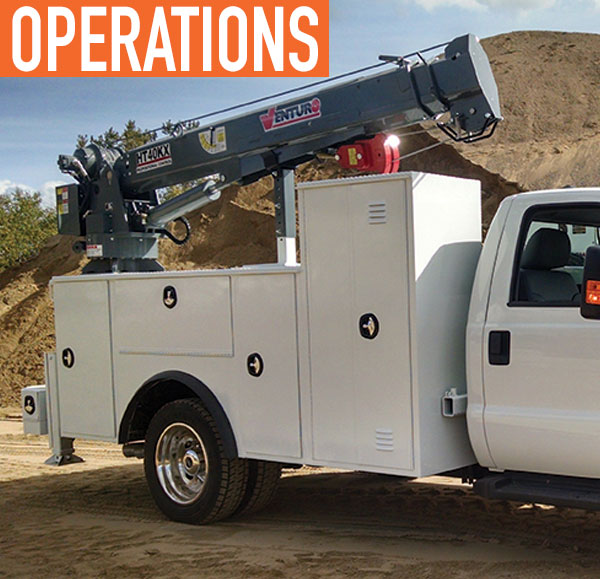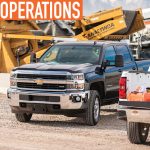Less than great cranes might leave your job unfinished or rushed. No manager or owner wants to be on the losing side of the crane battle. So what can you do to conquer heights and jobs? Pick an appropriate, reliable crane with a reliable crane management system that suits the job.
CRANE SIZE
To purchase the best crane for your business, you must first determine the weight of the maximum load to be lifted and the maximum distance that load is to be moved. Find the ft-lb rating needed for your crane by multiplying these numbers.
Many cranes are named with their ton rating and boom length listed within the name—for example, a Manitex TC50155HL crane has a boom length of 155 ft and a 50 ton rating. But don’t let the naming fool you. This doesn’t mean the crane can lift 50 tons at a length of 155 ft.
Crane manufacturer Venturo names its HT and ET cranes in ft-lb ratings. Its ET12 is a 12,000 ft-lb crane, and its HT25 is a 25,000 ft-lb crane. In this way, potential buyers have a more accurate knowledge of the capabilities of the crane.
CRANE TYPE
Should you choose a fully hydraulic crane or an electric hydraulic crane? This depends on the duty cycle of the crane or how often the crane is to be used in a 24-hour period. Will the crane be used only occasionally, making an electric-hydraulic crane sufficient? Or would the job require the crane to run longer than just a few minutes, calling for the use of a fully hydraulic crane?
Fully hydraulic cranes are designed for continuous use, like lifting water pumps from underground up to the surface. Using a hydraulic crane, operators can control the speed of the crane function, allowing them to feather the movements of the crane when needed for delicate movements, such as replacing a water pump. These cranes also feature booms that power-extend the entire length of the boom, whereas non-proportional and electric-hydraulic cranes only power-extend halfway.
Electric-hydraulic cranes feature electric motors designed for intermittent duty, or occasional use. Each crane allows a different constant run time, but most run between one and a half and three minutes of continuous use. Electric-hydraulic cranes also feature a variety of booms.
It isn’t difficult to determine which type of crane you’ll need. Just consider its potential duty cycle. The next step is to determine the crane your truck can support.

Venturo’s most popular electric crane, the ET12KX Electric-Hydraulic Service Crane has a maximum capacity of 3,500 lb, 12,000 ft-lbs.
TRUCK TYPE
There are two factors to take into consideration when deciding on a crane: GVWR and RBM. A truck’s GVWR is the number body builders use to determine how much weight a truck can hold and operate safely and effectively. This number includes payload. In addition to GVWR, we know that every truck has a resisting bending moment (RBM)—the point at which a truck’s frame could fail under too much pressure. Find your truck’s RBM from its dealer or manufacturer. It is important to know GVWR to determine what crane to use on your truck and important to know the RBM to determine how much of a load your crane can accommodate once it’s on your truck and in use.
Another important aspect to note is that fully hydraulic cranes require a PTO or another means to drive the hydraulic system. Electric-hydraulic cranes do not require a PTO, as they are self-contained units that run off the 12-volt electrical system of the truck.

The VLC control receiver for the new VLC Crane Control System.
CRANE CAPACITY
The capacity of a crane is stated in two ways: overturning moment and maximum lifting capacity. Overturning moment is usually referenced with pedestal cranes. Maximum lifting capacity is referenced with Mast cranes.
To determine overturning moment, you must: 1) determine the weight of the load; 2) determine the distance from the center of the crane rotation to the location of the load; and 3) multiply the distance by the weight. Therefore, if your load is 2,000 lbs at a distance of 10 ft, the overturning moment is 20,000 ft-lbs. It is important to determine the greatest ft-lbs requirement—or the “worst case scenario”—when selecting crane capacity.
MANAGEMENT SYSTEM
Even after you think you’ve found the perfect crane for your every need, a crane is only as good as its management system. Most crane manufacturers include a management system. Be sure to review the management system of the crane you’re interested in before you make a purchase.
Venturo created an electronic crane control management system that is simple and convenient. When you think of a crane management system, Venturo wants you to think “ROADS,” its acronym for Radio-remote, Overload protection, Alerts, Display, and Stability.
Venturo’s radio-remote, pistol-grip controller is a standard feature as part of its VLC system for all proportionally controlled hydraulic service cranes. Overload protection increases operator safety, controlling and preventing any type of overload on the crane. This results in a lighter-weighted crane, increasing payload capacity on your truck.
The VLC systems features four safety and capacity alerts as LCD display screen text, transmitter handle vibrations, green/yellow/red alert light located on the underside of the boom, and corresponding lights on the radio receiver. Real-time load and status LCD display shows percentage of load, boom angle in degrees, and percentage of total capacity during crane operation.
Venturo’s VLC system also features vehicle stability and grade control. When working with grades less than 4.5 degrees, operators receive full-capacity and normal operation of the crane. When working with grades between 4.5 and 6.5 degrees, all crane functions are reduced to 50 percent. For grades greater than 6.5 degrees, the winch-up, boom-out, and boom-down functions are automatically prevented to ensure your workers’ safety.
PERFECT FIT
When shopping for a crane for your business application, follow the steps above to ensure you pick the best crane for your job, and once you’ve followed those steps, review the crane management system. These steps and management systems are designed to keep your equipment, and most importantly, your workers safe.
FOR MORE INFORMATION
Find out more about Venturo’s crane and management system, visit www.venturo.com.
MODERN WORKTRUCK SOLUTIONS: OCTOBER 2018 ISSUE
Did you enjoy this article?
Subscribe to the FREE Digital Edition of Modern WorkTruck Solutions magazine.
![]()





